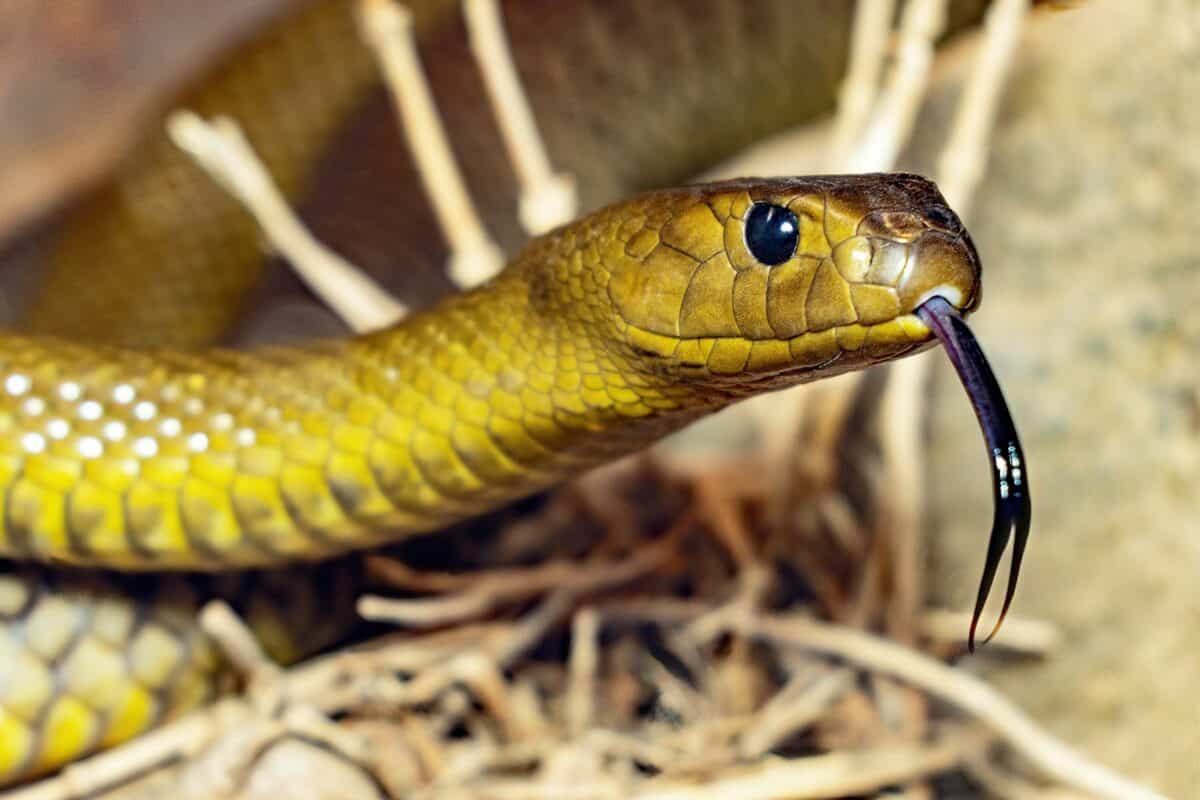When we think of dangerous animals, large predators like sharks, lions, and bears often come to mind. However, some of the world’s most lethal creatures are reptiles, whose ancient lineages have perfected the art of killing over millions of years of evolution. From venomous snakes that can deliver death in minutes to massive crocodilians capable of ambushing prey with lightning speed, deadly reptiles exist across continents and ecosystems. This article explores the 14 most dangerous reptiles alive today, examining their killing mechanisms, habitats, and what makes them such effective predators. While some may be encountered regularly in certain regions, others remain rare but no less deadly when paths cross with humans.
12. Inland Taipan The World’s Most Venomous Snake

The Inland Taipan (Oxyuranus microlepidotus), also known as the “fierce snake,” holds the title of the world’s most venomous snake based on the toxicity of a single bite. Native to the arid regions of central east Australia, this reptile possesses venom that is estimated to be 200-400 times more toxic than a common cobra’s. A single bite contains enough venom to kill approximately 100 adult humans or 250,000 mice. The inland taipan’s venom is a complex mixture of neurotoxins, hemotoxins, myotoxins, and nephrotoxins that can cause complete respiratory paralysis in as little as 30 minutes if left untreated. Despite its deadly potential, the inland taipan is surprisingly shy and reclusive, preferring to avoid human contact. This snake rarely encounters people due to its remote habitat, which has likely prevented many potential fatalities.
11. Saltwater Crocodile The Ultimate Ambush Predator

The Saltwater Crocodile (Crocodylus porosus) stands as the largest living reptile and one of the most formidable predators on Earth. Males can reach lengths exceeding 20 feet (6 meters) and weigh over 2,200 pounds (1,000 kg). These massive apex predators inhabit coastal brackish waters, river systems, and freshwater areas across Northern Australia, Eastern India, Southeast Asia, and parts of the Pacific. Saltwater crocodiles possess the strongest bite force of any animal alive today, measuring up to 3,700 pounds per square inch (PSI)—powerful enough to crush a human skull with ease. Their hunting technique involves stealth and explosive speed; they can remain nearly invisible with only their eyes and nostrils above water, then launch an attack at up to 30 mph (48 km/h). With an estimated 1,000-2,000 human fatalities annually, saltwater crocodiles are responsible for more human deaths than any other reptile species, earning them the ominous nickname “man-eaters.”
10. King Cobra The Snake That Rules Them All

The King Cobra (Ophiophagus hannah) demands respect as the world’s longest venomous snake, capable of reaching lengths of 18 feet (5.5 meters). Unlike most snakes that flee from human encounters, the king cobra is known for its confrontational behavior when threatened, raising up to one-third of its body off the ground and spreading its distinctive hood as a warning display. Found throughout forests in Southeast Asia, India, and southern China, these intelligent predators primarily feed on other snakes, including venomous species. A single bite from a king cobra can deliver enough neurotoxic venom to kill 20 people or an elephant. The venom attacks the victim’s central nervous system, leading to cardiovascular collapse, respiratory failure, and death within 30 minutes in severe cases. What makes the king cobra particularly dangerous is its precision—it can deliver multiple strikes in rapid succession, carefully controlling venom output with each bite. Despite their deadly reputation, king cobras typically avoid humans unless provoked, with most bites occurring when the snakes are cornered or their nests are threatened.
9. Black Mamba Africa’s Lightning-Fast Killer
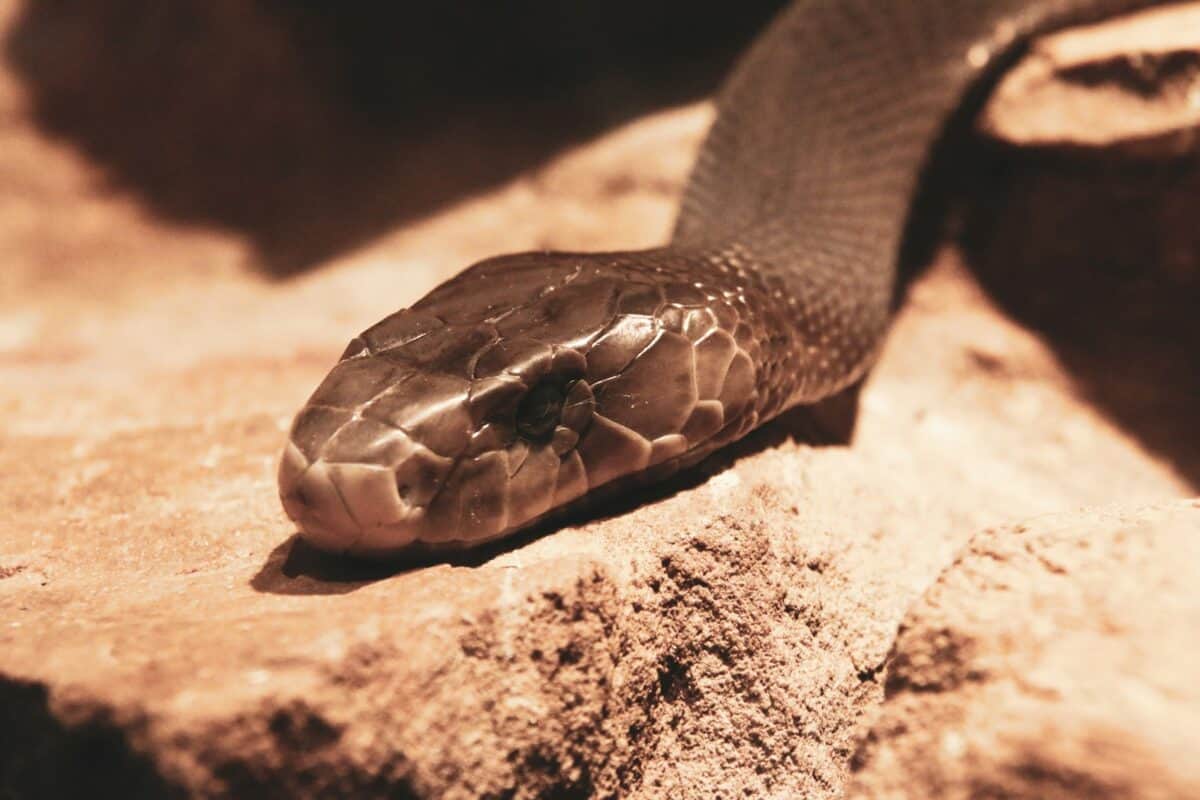
The Black Mamba (Dendroaspis polylepis) has earned its reputation as Africa’s most feared snake due to its combination of speed, aggression, and potent venom. Contrary to its name, the snake’s body is not black but rather olive to grayish-brown, with the “black” referring to the inside of its mouth, which it displays when threatened. These slender reptiles can grow up to 14 feet (4.3 meters) long and travel at speeds of up to 12.5 mph (20 km/h), making them the fastest land snake in the world. The black mamba’s venom is a complex cocktail of neurotoxins and cardiotoxins that can cause paralysis of the respiratory system within 20 minutes. Before antivenom became widely available, the mortality rate from black mamba bites approached 100%, often causing death within 7-15 hours. Found throughout savannas, rocky hills, and forests in sub-Saharan Africa, black mambas are known to be highly territorial and may deliver multiple strikes when threatened. Unlike many other venomous snakes that use their venom primarily for hunting, black mambas frequently employ it defensively, making them responsible for numerous human fatalities across their range.
8. Eastern Brown Snake Australia’s Silent Assassin
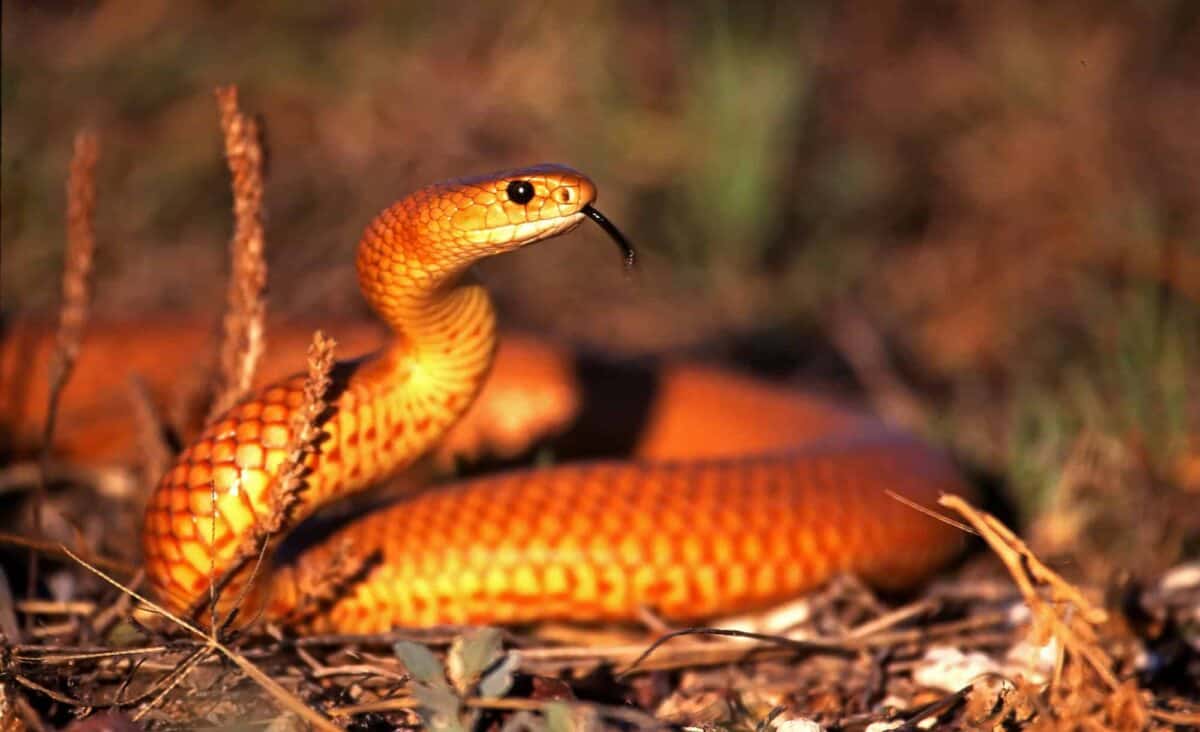
The Eastern Brown Snake (Pseudonaja textilis) ranks as the second most venomous land snake in the world and is responsible for more snakebite deaths in Australia than any other species. Growing to an average length of 5-7 feet (1.5-2.1 meters), these slender, fast-moving reptiles are found throughout eastern Australia and parts of Papua New Guinea, often thriving in populated areas and agricultural regions. Their excellent camouflage and tendency to freeze when threatened rather than flee makes accidental encounters with humans dangerously common. The eastern brown’s venom contains powerful neurotoxins and coagulants that can cause progressive paralysis and prevent blood clotting, leading to catastrophic hemorrhaging. What makes this snake particularly dangerous is how little venom is required for a lethal dose—just 1/14,000 of an ounce. Additionally, eastern browns are known for their nervous disposition and willingness to defend themselves aggressively when cornered. They can strike with incredible speed and accuracy, often delivering multiple bites in a single attack. Despite their deadly potential, fatalities have decreased significantly with improved medical response times and antivenom availability.
7. Nile Crocodile Africa’s Ancient Killer

The Nile Crocodile (Crocodylus niloticus) stands as Africa’s most prolific reptilian predator, with a documented history of human predation stretching back thousands of years. These massive reptiles can grow to lengths of 16-20 feet (5-6 meters) and weigh up to 1,650 pounds (750 kg). Distributed throughout sub-Saharan Africa in rivers, lakes, and marshlands, Nile crocodiles are estimated to kill hundreds of people annually. However, the exact number remains difficult to track due to unreported cases in remote areas. Their hunting technique involves patience and explosive power—they can remain motionless for hours before lunging with speeds reaching 22 mph (35 km/h) in water. Once they secure prey with their 64-68 conical teeth, Nile crocodiles employ the infamous “death roll,” spinning their bodies to tear off manageable chunks of flesh. Unlike many predators that avoid humans, Nile crocodiles appear to recognize humans as prey, particularly in areas where people regularly visit waterways for bathing, fishing, or collecting water. Their intelligence allows them to learn patterns in human behavior, often attacking at the same locations and times of day. Despite conservation efforts, conflict between Nile crocodiles and humans continues to increase as human populations expand into crocodile habitat.
6. Russell’s Viper: The Silent Killer of South Asia

Russell’s Viper (Daboia russelii) is responsible for more human deaths in India than any other snake species, with some estimates suggesting it causes up to 25,000 fatalities annually across its range. This heavy-bodied snake, growing to lengths of 4-5.5 feet (1.2-1.7 meters), inhabits open grasslands and agricultural areas throughout South and Southeast Asia, bringing it into frequent contact with rural populations. The snake’s distinctive chain-like pattern of oval spots along its back makes it recognizable, but many bites occur at night when the snake is nearly invisible in dim light. Russell’s viper venom is particularly devastating because it causes multiple life-threatening effects simultaneously: it destroys blood cells, causes internal hemorrhaging, induces kidney failure, and can trigger cardiac arrest. Even survivors often suffer permanent disability from tissue necrosis or kidney damage. What makes this snake especially dangerous is its temperament—when disturbed, it forms a tight S-shaped coil, hisses loudly, and can strike with tremendous force and accuracy. Unlike some venomous snakes that deliver dry bites (without venom), Russell’s vipers typically inject large amounts of venom with each bite. Their common presence near human settlements and agricultural fields means encounters are frequent, particularly for farmers working barefoot in rice paddies and fields.
5. Komodo Dragon The Venomous Dragon

The Komodo Dragon (Varanus komodoensis) is the world’s largest lizard, with males reaching lengths of 10 feet (3 meters) and weights exceeding 300 pounds (136 kg). Native to only five islands in Indonesia—Komodo, Rinca, Flores, Gili Motang, and Padar—these ancient predators represent one of the few reptiles that actively hunt large mammals, including deer, pigs, and occasionally humans. For decades, scientists believed bacteria in Komodo dragons’ mouths caused their prey to die from sepsis after being bitten. However, research has confirmed these lizards possess complex venom glands that secrete anticoagulants and shock-inducing proteins. When a Komodo dragon bites, this toxic cocktail prevents blood clotting, causes muscle paralysis, induces hypothermia, and triggers catastrophic drops in blood pressure. Their hunting strategy often involves inflicting a single bite before tracking wounded prey for miles as it succumbs to the venom’s effects. Komodo dragons have been documented killing humans, particularly on their native islands where locals coexist with these predators. Their incredible sense of smell allows them to detect blood and carrion from up to 2.5 miles (4 km) away, and they can consume up to 80% of their body weight in a single feeding. Despite their relatively small population of approximately 4,000 individuals, Komodo dragons remain apex predators with few natural enemies.
4. American Alligator North America’s Prehistoric Predator

The American Alligator (Alligator mississippiensis) represents one of North America’s most successful conservation stories, having rebounded from near extinction to a population now exceeding 5 million across the southeastern United States. These powerful reptiles typically grow to 11-15 feet (3.4-4.6 meters) in length and can weigh up to 1,000 pounds (454 kg). Unlike some reptiles on this list, alligator attacks on humans are relatively rare, averaging fewer than 10 per year, with fatal incidents occurring approximately once every three years. However, their potential danger should not be underestimated. An alligator’s bite force measures approximately 2,125 pounds per square inch—strong enough to crush turtle shells and bone. These ambush predators can launch themselves with explosive speed from water, capable of short bursts up to 35 mph (56 km/h) on land. Their hunting techniques have remained virtually unchanged for millions of years, combining patience with precise timing. American alligators have demonstrated remarkable adaptability to human encroachment on their habitat, and can be found in residential canals, golf course ponds, and other man-made waterways throughout their range. Notably, male alligators become particularly territorial and aggressive during mating season (April to June), when most serious attacks on humans occur.
3. Beaded Lizard Mexico’s Venomous Rarity
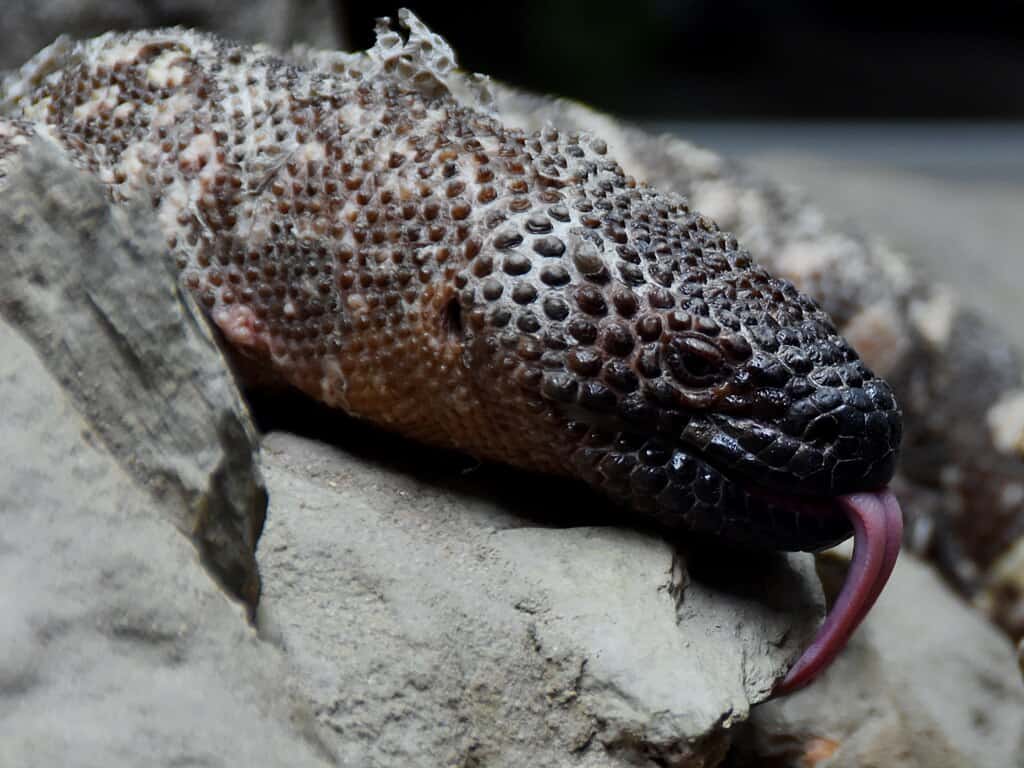
The Beaded Lizard (Heloderma horridum) is one of only two venomous lizard species in the world (alongside its close relative, the Gila monster). Native to Mexico and Guatemala, these stocky reptiles typically grow to 24-36 inches (60-90 cm) long and feature a distinctive pattern of yellow or white beadlike scales on a dark body. Unlike snakes that inject venom through hollow fangs, beaded lizards have venom glands in their lower jaws that secrete toxins into grooved teeth. When they bite, they latch on firmly and chew, allowing venom to flow into the wound. While rarely fatal to healthy adults, a beaded lizard bite causes extreme pain, swelling, lowered blood pressure, and can lead to respiratory failure in severe cases. These lizards are nocturnal and spend up to 90% of their lives in underground burrows, making human encounters relatively uncommon. Their venom evolved primarily to subdue small prey rather than for defense, but when threatened, beaded lizards adopt an intimidating stance, gaping their mouths and hissing loudly. Their slow metabolism means they can survive on as few as four meals per year. Despite their venomous nature, habitat destruction presents a far greater threat to beaded lizards than they do to humans, with the species now considered vulnerable to extinction.
2. Coastal Taipan Australia’s Deadly Maritime Snake

The Coastal Taipan (Oxyuranus scutellatus) ranks among the world’s most dangerous snakes, with venom approximately 10 times more toxic than that of a cobra. Native to coastal regions of northern and eastern Australia and the island of New Guinea, these snakes can reach lengths of 6.5-8.2 feet (2-2.5 meters). Their slender bodies and light brown to yellowish coloration make them difficult to spot in their preferred habitats of cane fields, grasslands, and tropical forests. What distinguishes the coastal taipan from many venomous snakes is its combination of extremely potent venom and aggressive defensive behavior. When threatened, coastal taipans are known to deliver multiple strikes with nearly 100% accuracy, injecting large amounts of venom with each bite. Their venom contains a complex mixture of neurotoxins and hemotoxins that attack the nervous system and blood, causing hemorrhaging, muscle damage, and eventually respiratory paralysis if left untreated. Prior to the development of taipan-specific antivenom in 1956, the mortality rate from coastal taipan bites approached 100%, with death occurring within 2-6 hours. Today, bites remain medical emergencies requiring immediate hospitalization, but fatalities are rare with proper treatment. Unlike their inland cousins, coastal taipans are more likely to encounter humans due to their habitat preferences, which increasingly overlap with agricultural and suburban areas.
1. Gila Monster North America’s Venomous Lizard

The Gila Monster (Heloderma suspectum) holds the distinction of being the only venomous lizard native to the United States. Found in the southwestern states of Arizona, Nevada, Utah, New Mexico, and parts of California, as well as northern Mexico, these distinctively patterned reptiles grow to lengths of 1.5-2 feet (45-60 cm). Their stocky bodies feature bright pink or orange patterns against a black background, serving as aposematic (warning) coloration to potential predators. Unlike venomous snakes that strike quickly, Gila monsters deliver venom through a chewing motion with grooved teeth in their lower jaw. Their venom is a complex mixture of proteins that causes extreme pain, dropping blood pressure, and profuse sweating, though fatalities are extremely rare. These lizards are remarkably adapted to their desert environment, storing fat in their tails and spending up to 95% of their lives underground to avoid extreme temperatures. They emerge primarily during the spring breeding season and after summer rains. Despite their venomous nature, Gila monsters are slow-moving and generally docile unless directly threatened or handled. Their venom has proven valuable to medical research, leading to the development of Exenatide, a medication used to treat type 2 diabetes. Due to habitat destruction and collection for the exotic pet trade, Gila monsters are now protected throughout their range.
Conclusion
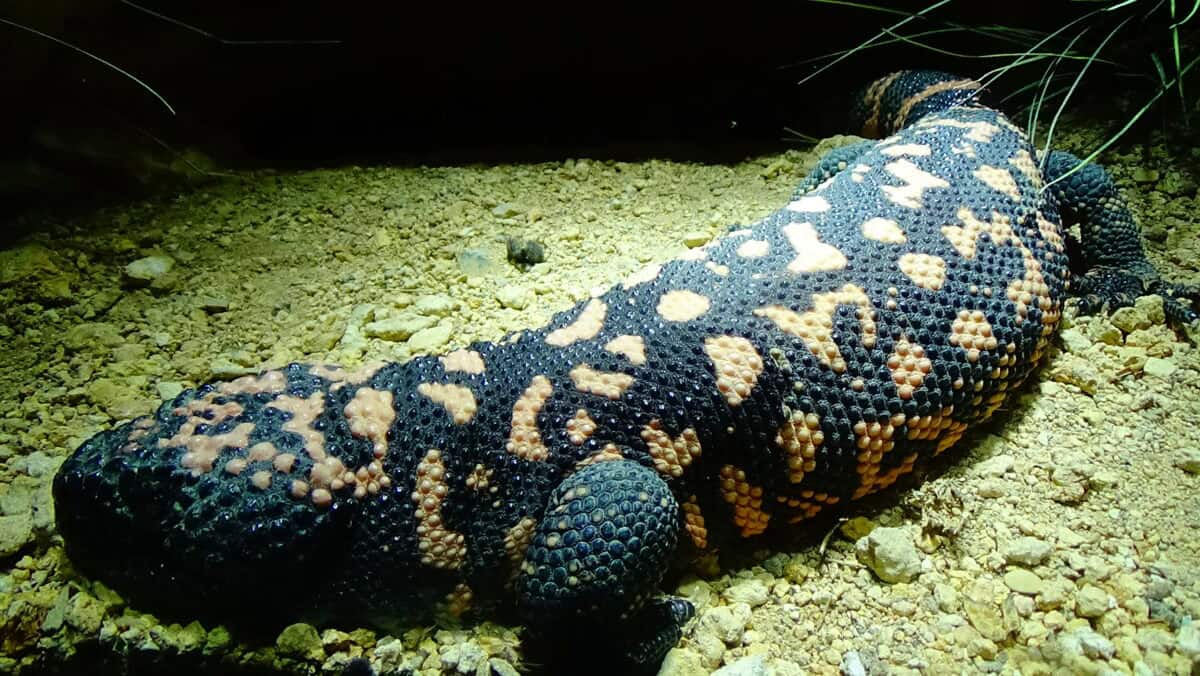
From venomous snakes to prehistoric-looking predators, these reptiles have mastered the art of survival—and killing—through millions of years of evolution. While many pose little risk unless provoked, their lethal capabilities are undeniable. Respecting their habitats and understanding their behavior is crucial, not only for our safety but also for conserving these ancient and extraordinary creatures that still roam our planet.
- 12 US States Where Wolves Are Making a Comeback - August 13, 2025
- 10 Most Dangerous Hiking Trails in the US - August 13, 2025
- 12 Creatures That Glow in the Dark and Why It Helps Them Survive - August 13, 2025

